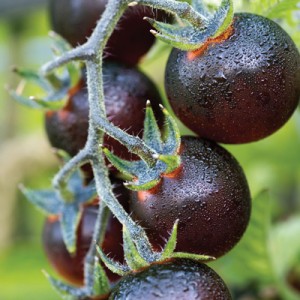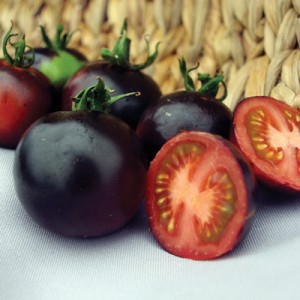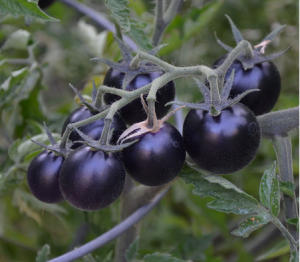Indigo Blue Berries
Posted in Horticulture on February 3 2015, by Sonia Uyterhoeven
Sonia Uyterhoeven is NYBG‘s Gardener for Public Education.

Something old,
something new,
something borrowed,
something blue,
and a silver sixpence in her shoe.
I wasn’t looking for blue. I was looking for black…the darkest shade I could find. But I found Indigo™ ‘Blue Berries’ in the pages of Territorial Seed catalog and fell in love. For clarity, Indigo™ ‘Blue Berries’ is Solanum lycopersicum—not Vaccinium corymbosum. If you’re not yet savvy with the nomenclature, that means we’re talking about tomatoes rather than blueberries.
The old English rhyme above was instruction for a bride on what to wear at her wedding. The list was full of superstitions and fertility prayers. That said, I am hoping that Indigo™ ‘Blue Berries’ will be not only fertile, but positively prolific. Let me start from the beginning.
In 2012, a new tomato appeared on the market named Indigo™ ‘Indigo Rose’. ‘Indigo Rose’ contains a pigment called anthocyanin. This pigment gives the fruit a deep purple, almost black color. Red tomatoes have a pigment called lycopene, orange tomatoes contain beta-carotene, and yellow tomatoes contain several other carotenoids. They are a pigment’s paradise, and hybridizers have taken full advantage of their kaleidoscope of colors.
Purple or black tomatoes have been around for a long time. Heirlooms such as ‘Cherokee Purple’, ‘Black Prince’, ‘Purple Calabash’, and ‘Japanese Black Trifele’ are well-known in the nursery trade. What you will notice about these purple-black heirloom precursors is that they are more of a brownish, purple-red color. They are very pretty, but a far cry from black—some are barely even purple. They contain a brown pigment called pheophytin that muddies when it combines with carotenoids.

‘Indigo Rose’ and her progeny were hybridized with a specific purpose in mind. Hybridizers at Oregon State University were interested in breeding tomatoes with high levels of antioxidants, so they crossed cultivated varieties with wild species from Chile and the Galapagos Islands.
Hybridizing tomatoes that contain anthocyanin was one of their goals. Blueberries (an antioxidant powerhouse) are probably the best known source of this pigment. It gives them their luscious blueberry color. Tomatoes do contain anthocyanin, but normally only in their leaves and stems.
These new black tomatoes contain about 1/10 of the anthocyanin that blueberries contain.
The potential health benefits of anthocyanins are numerous. This flavonoid has been known to be helpful in treating circulatory disorders, and some have anti-inflammatory and anti-bacterial properties. Antioxidants have the ability to bind with free radicals and potentially aid in the prevention of several diseases, including cancer and coronary heart disease. It is unclear whether anthocyanin acts as an antioxidant; it is more likely that it interacts in a complex manner within the body to increase antioxidant activity.
While health and wellness were strong aims for the Oregon State University hybridizing program, the end results were positively cool with regards to tomato aesthetic. These are swanky looking tomatoes that will catch even the most disinterested eye.
The tomatoes develop a glossy, deep purple hue when exposed to sunlight. If the fruit is shaded or the underside isn’t exposed to light, it will be green as it matures. The tomato is ripe when the glossy, blue-purple shoulders turn a slightly muted purple-brown and the green parts that were unexposed to the sun turn red. The tomato will also soften a bit, just like other tomatoes.

Pick the fruit and expose the non-purple areas to sunlight and they will turn purple in about a week. ‘Indigo Rose’ has a sweet taste with balanced sugars and acids. Eat it raw; it will remain purple. Cook it or juice it and the anthocyanins will leach out, leaving the fruit red.
After ‘Indigo Rose’ came a slew of other indigo tomatoes. ‘Indigo Rose’ was crossed with a yellow pear tomato to produce Indigo™ ‘Pear Drops’, and Indigo™ ‘Cherry Drops’ came from a cross with a red cherry tomato. They all boast the same lovely indigo shades and potential health benefits of their parent.
As you can see, there are a profusion of Indigo™ tomatoes on the market these days. This year we chose the small cherry tomato Indigo™ ‘Blue Berries’ for the Garden. The amusingly named Indigo™ ‘Dancing with Smurfs’ was another option for a dark cherry that received good taste test reviews. One of the tastiest on the market is the apricot-colored grape tomato with black shoulders named Indigo™ ‘Kumquat’.
The Territorial Seed Company has a solid collection of Indigo™ tomatoes, as does Trade Winds Fruit, which lists them under blue rather than black tomatoes.


WONDERFUL AS ALWAYS!
Sonia, you are a gem!!